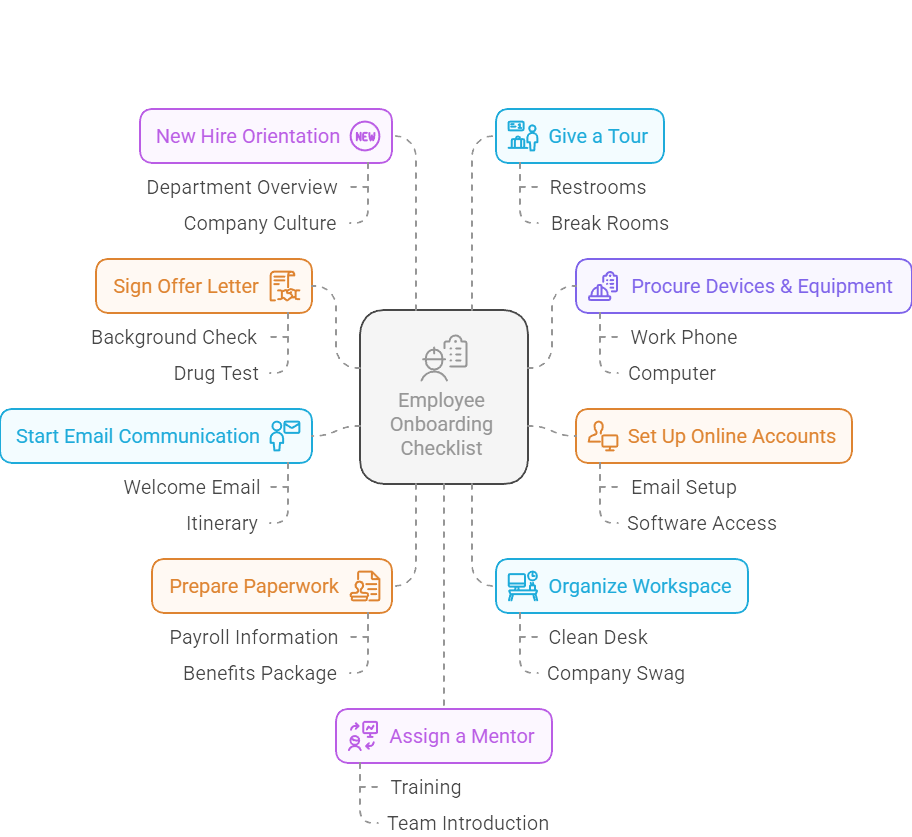
Giving new employees the ultimate onboarding experience is the key to retaining talent. New hire onboarding is defined as the process of integrating a new hire into an organization and introducing them to the company culture. During the onboarding program, it is the HR professionals’ responsibility to give the new hire all the tools and information that they need to be a productive employee.
In this article, you’ll find all the steps you need to include in your employee onboarding checklist.
Related articles:
What You Need to Know to Create an Effective Onboarding Process
11 Onboarding Best Practices You Need in 2024
What Do You Need an Employee Onboarding Checklist for?
An employee onboarding checklist is an extensive list that states all the steps HR professionals should take to properly onboard a new hire. You can keep this list in a document or on an online onboarding tool.
Onboarding new employees at a company usually takes at least 90 days. HR professionals are seeking ways to handle the onboarding process of a new employee’s experience to secure a high employee retention rate.
Although finding and recruiting the best candidates for a new position is difficult within itself, the work doesn’t stop once they’re officially hired. It is then the HR professionals’ job to ensure that new hires become content, successful, and productive new team members. AI in recruitment can assist in streamlining the hiring process, ensuring better candidate selection and faster onboarding.
Having checklists of all the activities that need to be completed helps HR to stay organized and compliant. Using a checklist also ensures consistency when it comes to delivering a positive onboarding experience to all new employees as soon as they start the first day of work.
The Employee Onboarding Checklist
In this section, we will go over the main activities of the employee onboarding process to newcomers joining. Make sure your list includes these items to ensure a smooth start to each employee journey after the hiring process. This will ensure that you enroll the newly hired employees into the best experience during the onboarding process.
We know you are a busy HR professional. For this reason, we have put together a 90-Day Employee Onboarding Plan which includes a complete checklist for the first 90 days of a new employee’s journey to welcome them into your top talent team.
1. Sign an Offer Letter: Make it Official with Your New Hire
The first step is to make it official by having all new hires sign an offer which indicates their acceptance of the position at your organization. There are sometimes stipulations to an offer letter such as making sure the new hire has completed a background check, drug test if required and gets their photo ID. Before initiating the background check, ensure you have an authorization form; online templates, like those from Freshdox, can help, but remember to customize them for state law compliance. Also, be sure to close the open job posting on all hiring sites.
2. Procure all Devices and Equipment
Before their start workday, procure all devices and equipment the new hire will need to perform their job duties. You should request all equipment and devices needed several days in advance to ensure it will all have arrived and be ready for the new hire’s first day. Some common examples are their work phone, computer, mouse, and headphones/earphones.
An increasingly popular solution is device as a service, where businesses can procure all necessary equipment—including laptops, monitors, and peripherals—on a subscription basis. This not only streamlines the process of obtaining the latest technology for new hires but also ensures ongoing maintenance and support, saving time and effort for HR and IT departments.
Not having all the equipment ready on the new hire’s first day makes your organization look unorganized and unprofessional. It creates the impression that the new hire isn’t that important or that maybe Human Resources forgot about them. On the other hand, if your company has everything ready, it creates the sense that the company is excited about the new hire and makes them feel valuable. It’s the first step in ensuring your organization has a high employee retention rates and subsequently gets you everything completed by the employee in time to place time on other tasks.
3. Set Up all Online Accounts
The next step is to set up all the new hire’s online and software accounts. Make sure all accounts and logins are set up prior to their arrival so that they can hit the ground running. HR professionals should coordinate with the accounting department, IT team, and facilities’ manager to ensure that the new hire has access to all relevant systems and has any needed access to enter the work building (if they aren’t remote). Lastly, make sure the new hire’s company email is all set up so they can quickly be up to date on all company news, updates, and information. To maintain a consistent and professional brand identity across all communications, be sure to provide email signature templates that align with company branding.
4. Start Email Communication
Before your new hire’s first day, the first email to the new hire should be a welcome email! The email should happily welcome them to the company and include all the essential details needed prior to their first day. It should state their start date, parking information or parking spot number, the company dress code, and the itinerary for what they should expect on their first day. Sharing this information will ensure that the new hire feels prepared, valued, and confident to start working.
Create engaging video onboarding films that introduce company, team member, and a few key procedures. It ain’t rocket science – use those budget-friendly tools like Movavi software to make sure your results are professional quality enough to make quite the fabulous first impression with your new starters.
5. Prepare Your New Hire Paperwork
Before your new hire walks through the door, it’s important to have all of their new hire paperwork prepared. Have the documents ready for new hires to fill out such as their payroll information, tax documents, and all the different agreements and contracts they need to sign. If your company uses paperless onboarding, you can also share the documents electronically for them to fill out before their first day in the new company.
Also, make sure to provide company’s employee handbook and make sure to explain their entire benefits package such as health-insurance, retirement-plan, and other perks they will receive. Be sure to give the new hire a point of contact they can ask any further questions like a reporting center or concerns they may have about their pay, benefits, or company policies and procedures. Provide the new hires’ job description and go over it with them together so there’s no confusion on what their official job duties are and will be.
6. Organize their New Workspace
The following step is to set up and organize a new hire’s workspace. It’s the HR professionals’ responsibility to ensure that the new hire has a clean desk, chair, laptop, headphones, and anything else needed to perform their job duties.
Then, gather as much company branded swag as you can to gift to your new hire! If your new hire will be working remotely, send them a company swag box to their home to give a push into having a great first impression. The swag can range from Christmas sweaters (if the season is right) to pens and custom mugs.
7. New Hire Orientation
The next step is to make sure your new hire is scheduled for their new hire orientation. Ideally, this would happen on their first day, but that’s not always plausible for all organizations. If it can’t be on their first day, ensure that the new employee orientation is scheduled soon within their first week of employment. New hire orientation is vital so the new hire can learn about all the various departments within the company (not just their own), review their new hire paperwork, learn the workplace’s organization chart, and learn about the company culture.
8. Give a Tour
The following step is to give the new hire a tour of the entire building. This is if your organization has a physical building of course. It’s important to give the new hire a tour and introduce them to all the leaders of each department. This will make them feel more included and minimize any awkward run-ins in future socialization. Ensure they at least are confident with knowing where the restrooms, common areas, and employee break rooms are located.
9. Give the New Hire a Mentor
The next step is to assign the new hire a mentor. Introduce your new employee to a coworker within their department who either has their same position or is a supervisor, who will act as their mentor, at least until their ‘trial’ period is completed. This mentor would be the point of contact for the new employee for any concerns, would ensure they’re fully trained, and introduce them to the rest of the team.
Whether through a formal mentorship program or an informal mentorship, helping every new hire find a mentor is a good way to ensure the new hire’s success. It’ll prevent the new hire from feeling alone throughout their onboarding process and give them an easy fix to any concerns or questions that may arise.
Discuss long-term growth opportunities and how the employee can advance within the company. For employees looking to explore additional career paths or opportunities, resources like Jooble can provide valuable insights into job markets and openings that align with their skills and aspirations.
10. Share the News of the New Hire’s Arrival
It’s important to send a new employee email announcement once your new employee has officially started at your organization. Using free email template creators, you can ensure a well-structured announcement is sent to co-workers and supervisors from other departments, reinforcing clear communication among employees. Share the news of their arrival to the workplace by sending an email and speak about the news during a company-wide meeting as well.
The announcement should say what position the new hire was hired for and what their job duties will be. But it should also entail some fun facts about the new employee like their professional background, hobbies, and interests. These announcements should encourage all new and existing employees to greet the newcomer and introduce themselves.
11. Get Onboarding Feedback
When the new hire reaches the important milestones of their onboarding process, schedule a meeting to get onboarding feedback. These milestones can include their first day, the first week and their first month with the organization.
These meetings will give HR professionals the chance to hear how the new employee is adjusting, and get their input on their individualized onboarding process. This conversation is important in order to expose areas of the onboarding process that could use some improvement or learn additional things that should be added to the onboarding process in order to give future new hires more job-training that could benefit them. This also lets the new hire know they and their opinion are valued within the company.
12. Touch Base at Regular Intervals
Lastly, it’s essential to touch base with the new employee at regular intervals to ensure the employee experience and how well they are adapting to their orientation process. Although you’ve already met with them once after onboarding, the meetings shouldn’t stop there. There’s always more feedback and questions to be given, and new hires are more likely to express such when asked!

Onboarding doesn’t stop after the paperwork is done. You have to be up-to-speed with all your systems to have a smooth working environment that may enhance the employee orientation program and the continuation of their daily work. This can be done with a platform to consolidate all your data and software on a single platform such as PeopleSpheres. This will bring a better organizational-culture to your company while having a better turnover rate for employees.
For new employees, it is also important that there are mentors and meetings with the new hire after 30, 60, and 90 days after arriving at the workplace. These meetings will give the new hire an opportunity to give feedback on their new role, any questions or concerns they have on their new employee training training plan, and how they’re overall adapting to their position and the company. By addressing their questions and concern, we can help them feel confident in that their decision to join your company was the right one.




